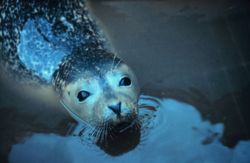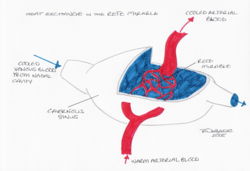Difference between revisions of "Thermoregulation in Skin - Anatomy & Physiology"
(No difference)
| |
Latest revision as of 18:00, 29 June 2012
Introduction
In order to maintain a constant body temperature as is possible in homeotherms, heat must be transported to the surface of the skin via the blood and released into the environment via conduction, convection, radiation or the evaporation of sweat. The cooled blood then returns to the body core, thus reducing core temperature. If heat from metabolism were not removed from the body, the core temperature of mammals and birds would increase by approximately 2.5 C per hour.
Physiology
When the body's heat production is stable, the blood flowing into the dermis is regulated depending on changes in ambient temperature. The purpose of this regulation is to ensure that the difference in temperature between the skin's surface and the environment remains constant, thus regulating heat loss and maintaining an almost constant body temperature. When heat production increases, blood flow to the dermis also increases, which, in turn, increases the heat lost from the skin to the same rate as the excess heat production.
Heat transported from the body core to the skin's surface, will pass through subcutaneous adipose tissue, dermis, and finally to the epidermis, after which, the heat passes through air trapped in fur or plumage. Adipose tissue is a poor conductor of heat, therefore, even a thin layer will confer some insulation against heat loss.
The extent of heat lost from the skin is dependent on the amount of blood flow to the dermis. As blood flow decreases due to vasoconstriction of the subcutaneous vessels, the insulating effect of the skin increases. In theory, the more vasoconstriction that occurs, the closer to environmental temperature the skin's surface will become, although this depends greatly on the environmental temperature. If the enviromental temperature is very low, a difference between environmental and skin temperature will always exist and therefore some heat loss will invariably occur. Similarly, if the environmental temperature is very high, there will never be a great enough difference for heat loss to occur, and therefore other ways of losing heat from the body, such as sweating and panting, must be employed. If blood flow to the dermis increases, however, heat loss through the skin increases as the temperature difference between the skin and the environment also increases. The insulation provided by the adipose tissue can therefore be somewhat bypassed if the blood flow to the dermis is great enough.
Blood flow to the dermis can vary by a factor of 3 to 5, depending on the requirement for heat loss or conservation. This blood flow is regulated by the sympathetic nervous system. An increase in core body temperature causes a decrease in the tone of the smooth muscle walls of the arterioles due to a reduced impulse frequency in the sympathetic nerve fibres. This casues vasodilation, which in turn, increases cutaneous blood flow and therefore heat loss. The opposite is true for a decrease in core body temperature.
Effect of Fur and Feather
In mammals with a haircoat and birds with a full plumage, a layer of air is trapped between the surface of the skin and the outer surface of the haircoat or plumage. Air has a low heat capacity and is a poor conductor of heat, therefore it serves as an insulator. The degree of insulation conferred by fur and feather can be altered by increasing or decreasing the thickness of the air layer. This is acheived by the arrector pili muscle in the dermis.
If this insulating layer of air is replaced by water, heat is readily lost from the skin's surface, leading to a decrease in core body temperature and ultimately hypothermia. The layer is protected by secretions from the skin onto the fur or feathers. In birds, secretions from the uropygial gland maintain the water repellant properties of the plumage. In mammals that are regularly exposed to water, a thick layer of subcutaneous adipose tissue of blubber is present as the insulating air is completely lost and replaced by water.
Shivering
In cold conditions, muscles can also receive messages from the thermo-regulatory centre of the brain (the hypothalamus) to cause shivering. This increases heat production as respiration is an exothermic reaction in muscle cells. Shivering is more effective than exercise at producing heat because the animal remains still. This means that less heat is lost to the environment via convection. There are two types of shivering: low intensity and high intensity. During low intensity shivering animals shiver constantly at a low level for months during cold conditions. During high intensity shivering animals shiver violently for a relatively short time. Both processes consume energy although high intensity shivering uses glucose as a fuel source and low intensity tends to use fats. This is why animals store up food in the winter.
Sweating
Sweating is controlled from a centre in the preoptic and anterior regions of the hypothalamus where thermosensitive neurons are located. The heat regulatory function of the hypothalamus is also affected by inputs from temperature receptors in the skin. High skin temperature reduces the hypothalamic set point for sweating and increases the gain of the hypothalamic feedback system in response to variations in core body temperature. Overall, however, the sweating response to a rise in hypothalamic ('core') temperature is much larger than the response to the same increase in average skin temperature. As sweat also contains ions in addition to water, sweating requires the intake of salts and water to maintain fluid homeostasis.
Not all animals can sweat, however, and they must therefore use a different method of cooling when the environmental temperature is very high. Dogs, for example, pant to increase their heat loss.
Panting
Dogs, cats, ruminants and birds pant, whereas horses, pigs and most small animals cannot. Panting requires fast, shallow breathing at the natural resonant frequency of the airways. Little mechanical energy is required to facilitate panting, therefore, heat production in the respiratory muscles is minimised. The main mechanism of heat loss during panting is by water evaporation from the moist mucous membrane of the nasal cavity. The heat of evaporation is removed from the tissues of the nasal cavity, cooling its blood supply. The cooled blood is collected in large venous sinuses and then passes through the rete mirable which functions as a heat exchanger, cooling arterial blood to the brain.
Under moderate heat stress, ruminants pant with a closed mouth. Under significant heat stress, however, all animals pant with open mouths. This means that air with a high water content cannot condense on the mucosa of the nasal cavity, thus maximising the heat lost through evaporation. There is also some evaporation from the oral membranes.
Error in widget FBRecommend: unable to write file /var/www/wikivet.net/extensions/Widgets/compiled_templates/wrt67388812445c51_58020164 Error in widget google+: unable to write file /var/www/wikivet.net/extensions/Widgets/compiled_templates/wrt673888124a9367_27157327 Error in widget TwitterTweet: unable to write file /var/www/wikivet.net/extensions/Widgets/compiled_templates/wrt6738881252d3a1_21917907
|
| WikiVet® Introduction - Help WikiVet - Report a Problem |

